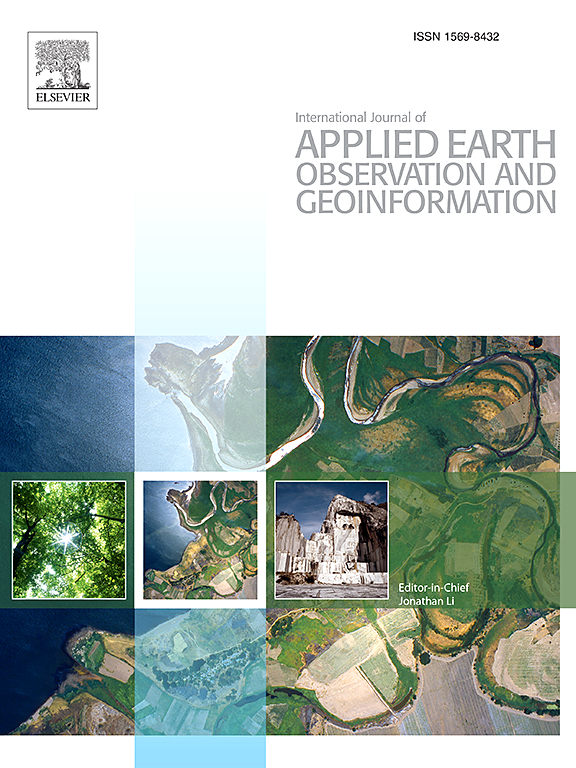黄土高原近40年多卫星降水产品适用性评价
IF 8.6
Q1 REMOTE SENSING
International journal of applied earth observation and geoinformation : ITC journal
Pub Date : 2025-06-04
DOI:10.1016/j.jag.2025.104634
引用次数: 0
摘要
近年来,全球变暖导致的干旱和降水演变研究受到了科学界的广泛关注。黄土高原是典型的旱地农业区,其农业发展受到降水的影响。然而,由于地处欧亚大陆腹地,地形复杂,雨量计严重缺乏,该地区在精确测量降水方面面临挑战。多卫星降水产品(mpp)具有广泛的覆盖范围和高分辨率,可以潜在地解决这一缺陷,因此评估其在LP上的适用性至关重要。本文评价了mpp对低海拔降水变化的反演结果、降水变化的影响因素以及影响低海拔降水演变的动力机制。结果表明,CPC与观测值的相关系数最高,为0.774,检测概率最高,为0.667,是反演LP日降水的最合适产品。这要归功于CPC使用了稳定的数据源和优秀的算法。2000年以来,低海拔地区降水呈现明显的上升趋势,热项对低海拔地区的湿化起着重要作用。分析表明,全球变暖增加了大气水分含量,西风急流增强和近地面偏东异常将北大西洋和东海的暖湿空气输送到低压。阐明低海拔地区的降水趋势和动态可以为农业发展提供有价值的政策支持。本文章由计算机程序翻译,如有差异,请以英文原文为准。
Assessment of the applicability of multi-satellite precipitation products on the Loess Plateau over the past four decades
The study of drought and precipitation evolution due to global warming has garnered significant attention from the scientific community in recent years. The Loess Plateau (LP), a typical dryland agricultural area, has its agricultural development influenced by precipitation. However, given its location in the hinterland of the Eurasian continent, the complex terrain, and the severe lack of rain gauges, the region faces challenges in accurate precipitation measurement. Multi-satellite precipitation products (MPPs), with their wide coverage and high resolution, can potentially address this deficiency, making it crucial to assess their applicability on the LP. This study evaluates the results of the inversion of LP precipitation changes by MPPs, the factors influencing the precipitation changes, and the dynamical mechanisms affecting LP precipitation evolution. The findings indicate that the CPC is the most suitable product for inverting daily precipitation on the LP, with the highest correlation coefficient of 0.774 between CPC and observations, and the highest Probability of Detection of 0.667. This is attributed to the stable data sources and excellent algorithms used by CPC. Furthermore, the LP has exhibited a significant upward trend in precipitation since 2000, with the thermal term playing a significant role in the humidification of the LP. The analysis suggests that global warming increases atmospheric moisture content, and enhanced westerly jet and near-surface easterly anomalies transport warm, humid air from the North Atlantic and the eastern China Sea into the LP. Clarifying the precipitation trends and dynamics in the LP can provide valuable policy support for agricultural development.
求助全文
通过发布文献求助,成功后即可免费获取论文全文。
去求助
来源期刊

International journal of applied earth observation and geoinformation : ITC journal
Global and Planetary Change, Management, Monitoring, Policy and Law, Earth-Surface Processes, Computers in Earth Sciences
CiteScore
12.00
自引率
0.00%
发文量
0
审稿时长
77 days
期刊介绍:
The International Journal of Applied Earth Observation and Geoinformation publishes original papers that utilize earth observation data for natural resource and environmental inventory and management. These data primarily originate from remote sensing platforms, including satellites and aircraft, supplemented by surface and subsurface measurements. Addressing natural resources such as forests, agricultural land, soils, and water, as well as environmental concerns like biodiversity, land degradation, and hazards, the journal explores conceptual and data-driven approaches. It covers geoinformation themes like capturing, databasing, visualization, interpretation, data quality, and spatial uncertainty.
 求助内容:
求助内容: 应助结果提醒方式:
应助结果提醒方式:


